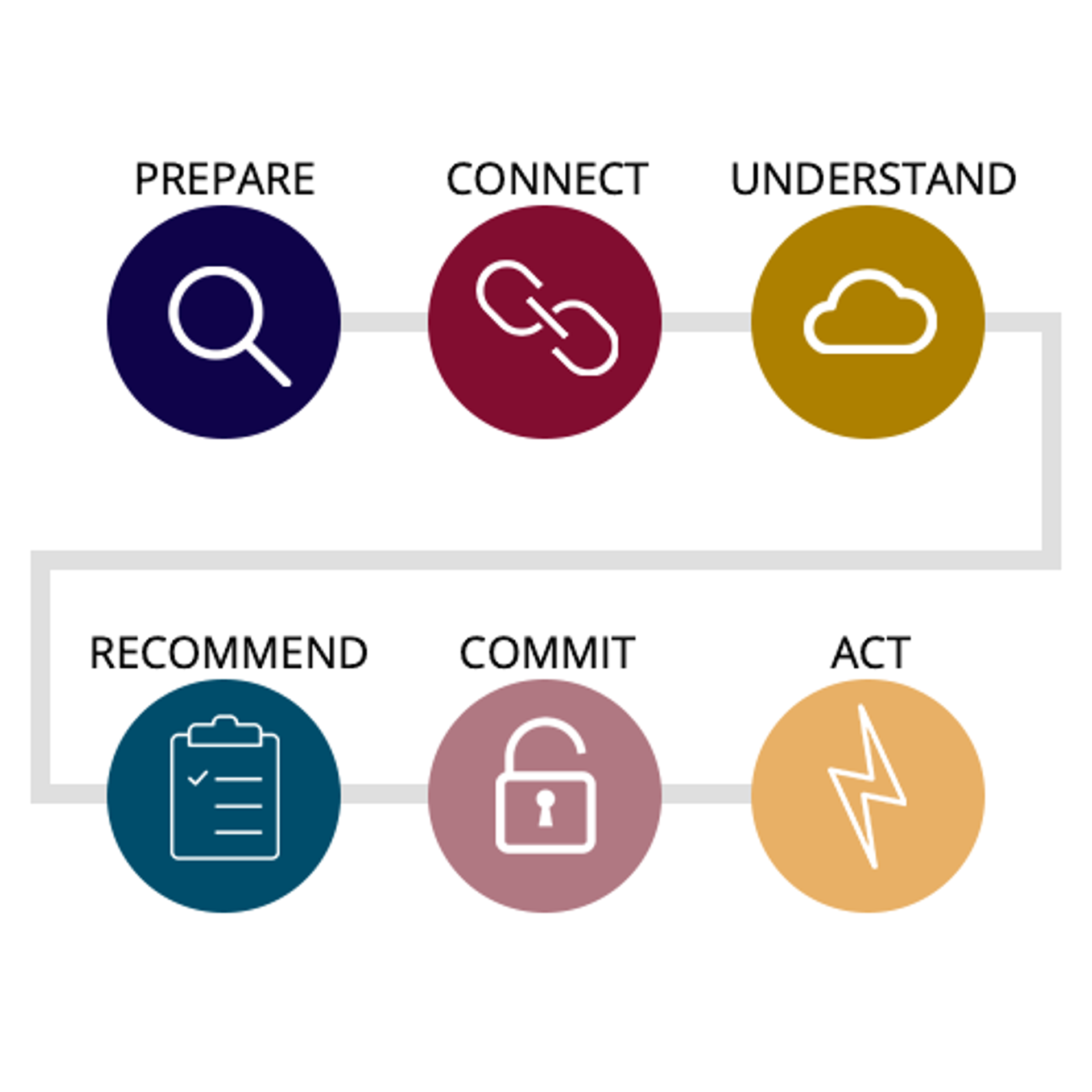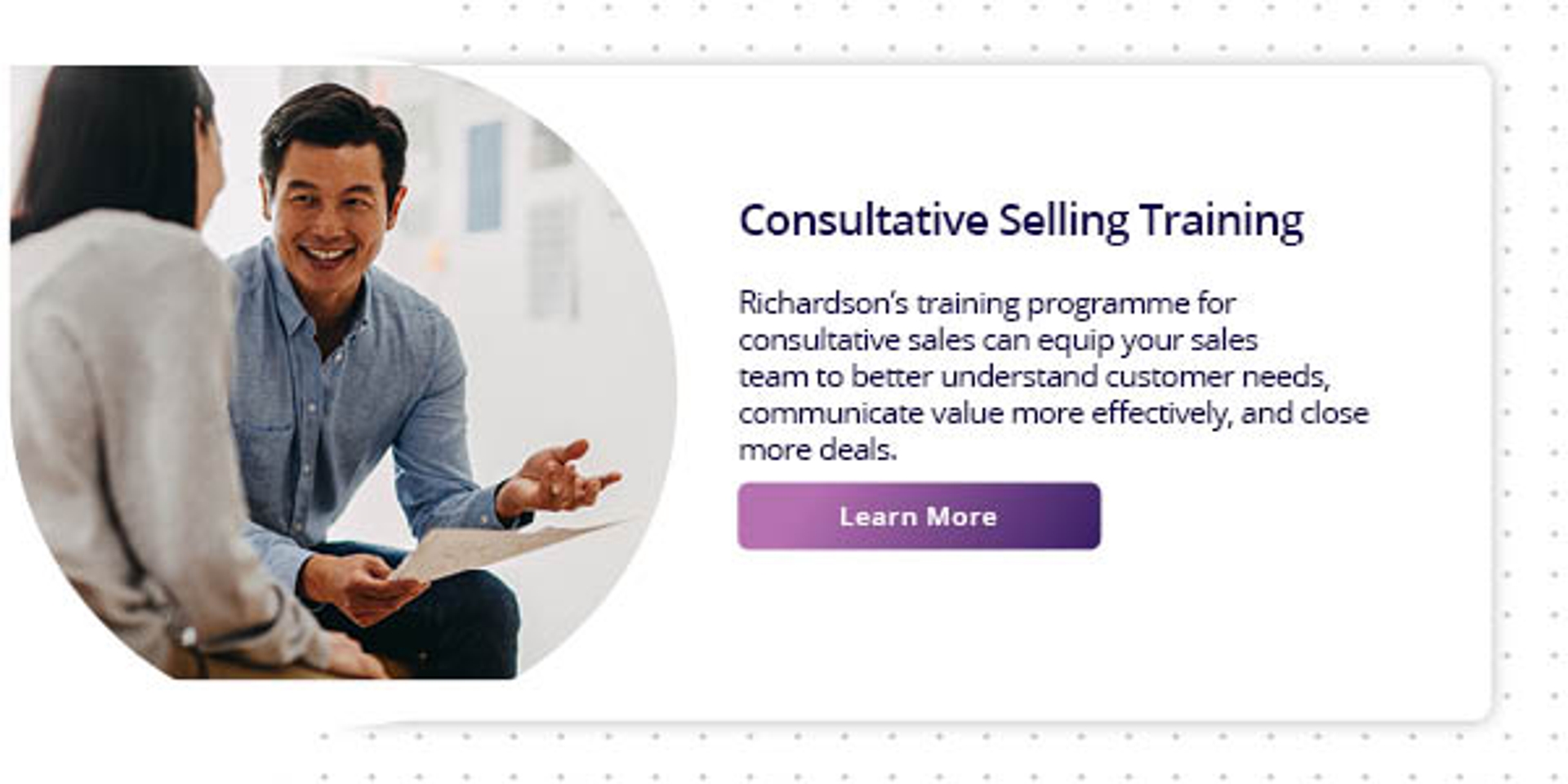Everything You Need to Know About Consultative Selling
Outbound sales

What Is Consultative Selling?
Consultative selling is a sales approach that prioritises relationship building and open dialogue to address a customer’s needs. Conversation is focused on the customer’s challenges and goals, rather than the product’s features. By understanding the challenges faced by customers, sellers can position their products as tailored solutions. Using a consultative approach can lead to increased satisfaction and stronger buyer-seller relationships.

The Consultative Selling Framework
The Consultative Selling Framework provides sellers with a consistent, repeatable process to execute sales conversations more effectively.
The Framework consists of 6 steps prepare, connect, understand, recommend, commit, and act.
In the next section, we'll explore each of these steps in more detail.
1. Prepare
Research your prospect’s role, as well as common challenges in their industry and recent changes at their company, to plan for a productive and engaging meeting.
Check out our suite of sales tools that help embed best practices, like call preparation, into your sales team's workflow.
2. Connect
Use rapport-building skills to set a positive tone for the meeting and build trust to ensure the buyer is comfortable sharing critical information.
3. Understand
Use questioning skills to develop a deep understanding of the buyer's needs.
4. Recommend
Formulate a value statement that draws clear connections between the customer's challenges and the proposed solution using straightforward language.
5. Commit
Use process-focused communication to start closing. This step is often repeated as new stakeholders enter the conversation and the details of the solution and contract are finalised. At this stage, sellers should use agile sales techniques to get the deal over the finish line.
6. Act
Maintain flawless follow-up with the customer to boost credibility and build momentum toward the final close.
Watch the video below to take an even deeper dive into the 6 elements of the consultative selling framework.
Understanding Customer Needs in Consultative Selling
One of the core tenants of consultative selling is: a sales professional must use authentic curiosity to deeply understand customer needs.
Some examples of consultative-style questions that demonstrate genuine curiosity are:
- What do you want to achieve?
- What are your current methods?
- What’s working well?
- To ensure that we are future-focused in our recommendations, what are your plans going forward?
The answers to these questions provide vital insights into the customer’s challenges. Following the consultative sales process improves the seller’s ability to resolve objections and position solutions to advance the sale.
RELATED: Watch examples of the right and wrong ways to solve sales objections here.
Consultative Sales Skills and Techniques
In consultative selling, the sales professional learns about customer needs before talking about a product or solution. Product knowledge is transformed into a tailored solution that is positioned based on the customer’s needs.
For successful consultative selling discussions, focusing on avoiding being seller-centric, embracing authenticity, leading the conversation with a plan, building decisive momentum,using insights through questioning, understanding the buyer's behavioural psychology, and working from facts not assumptions.
In the next section, we explore these 7 key behaviours in greater detail.
1. Avoid Being Seller-centric
Many sellers believe they’re customer-focused, but few truly are. Sales professionals facing pressure to close often resort to seller-centric behaviours to try to strong-arm customers or gloss over concerns. However, these behaviours erode trust.
Sellers need to understand the person in the other chair. Doing so means forming an accurate diagnosis of their problem. This insight improves the seller's ability to effectively position solutions and build trust with the customer.
2. Embrace Authenticity
Sales professionals must give before they get. Prioritise solving the buyer’s business challenges early in the process to foster openness.
This openness helps sellers more accurately diagnose their buyer’s challenges, stated needs, and unknown needs. Using this information, the seller can show the buyer the right data to reach a resolution.
3. Lead the Conversation with a Plan
A direct approach that starts the conversation with a clear intent helps sellers gain an early indication of the buyer’s expectations. If the intended path isn’t aligned with the buyer’s goals for the conversation, the seller can adjust accordingly.
4. Build Decisive Momentum
Sales professionals can guide the buyer through the dialogue by eliciting feedback. This helps them get a sense of how well they understand the solutions and ideas discussed.
This periodic checking develops commitment incrementally throughout the buying process. It also builds decisive momentum in which alignment with the buyer makes each successive decision easier than the last.
5. Demonstrate Insights through Questioning
Asking progressively smarter questions helps the buyer connect the dots with a line that traces to the best solution.
Insightful questions quickly get to the core issues and enable the seller to float ideas. Buyers will be more open to thinking differently about solutions when the concepts are presented as questions.
6. Understand Buyer Behavioural Psychology
Buyers are human beings, and human beings have three fundamental needs for well-being that affect how they perceive what is happening, what they listen to, and how they ultimately make decisions.
These needs are Autonomy, Competence, and Relatedness. Strong questioning skills help sellers respect these needs by staying emotionally connected with the buyer, avoiding coming across as manipulative, and creating a safe environment to discuss challenging or sensitive issues.
7. Work from Facts, Not Assumptions
Anchoring is a form of cognitive bias where a person relies too heavily on one piece of information. Inexperienced sellers usually anchor to their own assumptions rather than seeking out the facts through dialogue.
Anchors can cause sales professionals to miss valuable information that could advance the sales process by positioning a more compelling solution.
To counteract anchoring, the best sellers use active listening to “tune into” new or conflicting information. They aren’t afraid to ask tough questions because they know that the facts will lead to the most compelling value proposition.
RELATED: Learn how to practice these critical behaviours through role-play exercises for consultative sales.
Benefits of Adopting a Consultative Selling Approach
In sales, "consultative" and "solution" are often overused terms. However, true solutions require a consultative approach. Without being consultative, the so-called solution is usually little more than a standard product pitch.
Sales professionals who genuinely embrace the consultative approach experience many benefits, including:
- Increased revenue from improved close rates and customer expansion
- Competitive advantage from a market-aligned sales approach
- Uncovered opportunities within current accounts from surfacing unrecognised needs
- Shortened sales cycles by driving momentum and building buyer confidence to commit
Why the Consultative Approach is Better for Modern Buyers
Market changes drove the shift from product-focused to needs-focused selling. Modern buyers:
- Are more informed
- Are more skeptical
- Must answer to an increasing number of stakeholders
- Face more complexity and ambiguity in their roles
- Are less loyal to their existing solutions providers
Technology, skepticism, risk-averseness, and numerous stakeholders challenge the seller-buyer connection and prolong the sales cycle. This problem is further compounded by sellers underestimating buyers' level of research, as well as limited access to buyers amid tight schedules.
While these factors seemingly raise the buyer to an unreachable height, sellers must remember they offer their own critical skills. Buyers still seek trust, authenticity, and clarity to help them synthesise value from their resources. Sellers can differentiate themselves by delivering on these needs.


White Paper: Elevate Your Consultative Selling Approach to Compete Today
DownloadGet industry insights and stay up to date, subscribe to our newsletter.
Joining our community gives you access to weekly thought leadership to help guide your planning for a training initiative, inform your sales strategy, and most importantly, improve your team's performance.







